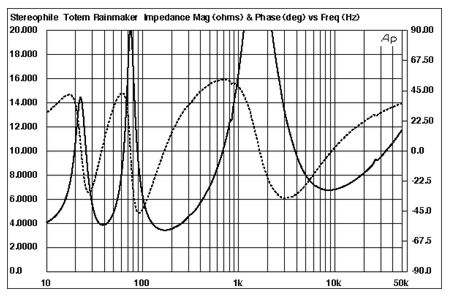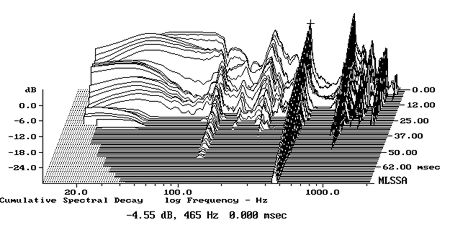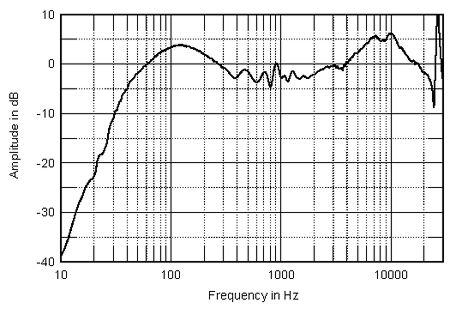| Columns Retired Columns & Blogs |
Totem Acoustic Rainmaker loudspeaker Measurements
Sidebar 3: Measurements
Despite its diminutive size, the Totem Rainmaker was only just below average in its voltage sensitivity, at an estimated 86.5dB(B)/2.83V/m (though this will be due in part to its exaggerated treble; see later). Its impedance magnitude dropped below 4 ohms in the lower midrange, reaching a minimum value of 3.4 ohms at 170Hz (fig.1), which means a good 4 ohm–rated amplifier will work best with the speaker. The saddle at 39Hz in this graph's magnitude trace indicates the tuning of the rear-mounted port, while the fact that the height of the upper-frequency bass peak is greater than that of the lower-frequency implies a rather underdamped reflex alignment.

Fig.1 Totem Rainmaker, electrical impedance (solid) and phase (dashed). (2 ohms/vertical div.)
The small glitch at 26.4kHz is due to the aluminum-dome tweeter's "oil-can" resonance, which should be subjectively benign. However, there are also discontinuities lower in frequency, between 300 and 900Hz, that indicate the presence of some kind of cabinet resonances, either acoustic or vibrational. The enclosure did seem lively to the traditional knuckle-rap test, and investigating the panels' vibrational behavior with an accelerometer revealed some high-amplitude resonances (fig.2). It's possible that the slightly nasal quality that Bob Reina noted in his auditioning stemmed from the higher-frequency resonant modes. (Nasality is caused by problems in the 800Hz–2kHz region, in my experience.)

Fig.2 Totem Rainmaker, cumulative spectral-decay plot calculated from the output of an accelerometer fastened to the cabinet's top panel (MLS driving voltage to speaker, 7.55V; measurement bandwidth, 2kHz).
From left to right, fig.3 shows the individual outputs of the Rainmaker's port, woofer, and tweeter. The port response peaks between 30 and 60Hz, a little too low in frequency and level to extend the woofer's response by much. However, this tuning does boost the woofer's output in the upper bass (some of the peak between 100 and 200Hz in the woofer's response in fig.3 will be due to the nearfield measurement technique, but the rest is real), resulting in the impression that the speaker has better bass extension than might be expected from its size. This is the old "LS3/5a" trick, which worked so well for the BBC's classic small speaker design.

Fig.3 Totem Rainmaker, acoustic crossover on tweeter axis at 50", corrected for microphone response, with the nearfield woofer and port responses plotted below 350Hz and 1kHz, respectively.
The downside of this tuning is that the speaker's treble also needs to be boosted a little for it to work, which is presumably why the Rainmaker's tweeter is balanced higher in level than is required for strict accuracy, though also higher than I would have liked to have seen. The crossover appears to be set at around 2kHz, and while both drive-units initially roll off smoothly away from their passbands, the woofer's curve is broken up by what are probably some cone breakup peaks. These are suppressed by the crossover, however.
Note that the port output has some vicious-looking resonant spikes at 460, 840, and 925Hz, coinciding both with the frequencies of the ripples seen in the impedance traces in fig.1 and those of the cabinet vibrational modes shown in fig.2. (This suggests that they are not vibrational modes but internal air-space resonances exciting the panels.) Because the port faces toward the speaker's rear, it's possible that the audibility of these modes will be diminished. However, these resonances do result in ripples in the farfield output, evident both in this graph and in the Rainmaker's overall response, averaged across a 30 degrees horizontal window centered on the tweeter axis (fig.4). As I said earlier, it's likely that this behavior leads to the nasality mentioned by BJR. Fig.4 also shows the LS3/5a-like balance.

Fig.4 Totem Rainmaker, anechoic response on tweeter axis at 50", averaged across 30 degrees horizontal window and corrected for microphone response, with the complex sum of the nearfield woofer and port responses, taking into account acoustic phase and distance from the nominal farfield point, plotted below 300Hz.
The Rainmaker's horizontal dispersion is shown in fig.5. It is relatively uniform, except for a slight flare at the bottom of the tweeter's passband that will ameliorate the effect of the boosted top two octaves in rooms of small to medium size, provided these are not too acoustically dead. The plot of the Totem's vertical dispersion (fig.6) indicates that the listener should use stands that place his ears level with the tweeter for the optimal perceived balance, as a major suckout in the crossover region develops more than 10 degrees above or below this axis.

Fig.5 Totem Rainmaker, lateral response family at 50", normalized to response on tweeter axis, from back to front: differences in response 90 degrees–5 degrees off-axis, reference response, differences in response 5 degrees–90 degrees off-axis.

Fig.6 Totem Rainmaker, vertical response family at 50", normalized to response on tweeter axis, from back to front: differences in response 45 degrees–5 degrees above axis, reference response, differences in response 5 degrees–45 degrees below axis.
In the time domain, the Rainmaker's step response on the tweeter axis (fig.7) reveals that both drive-units are connected with the same positive acoustic polarity, with a smooth transition between their outputs. The cumulative spectral-decay plot (fig.8) is very clean, except for the perturbations around 1kHz. This is especially commendable, considering the speaker's low price.

Fig.7 Totem Rainmaker, step response on tweeter axis at 50" (5ms time window, 30kHz bandwidth).

Fig.8 Totem Rainmaker, cumulative spectral-decay plot at 50" (0.15ms risetime).
As always from Totem, the Rainmaker's measured performance reveals some excellent speaker engineering. However, I would have preferred not to have seen those cabinet resonances in the upper midrange.—John Atkinson
- Log in or register to post comments




































